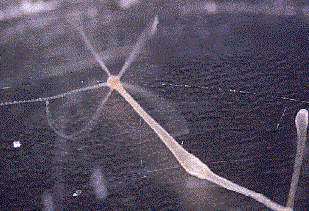Introduction to the Hydrozoa
 |
A great many hydrozoans are also colonial. Some form delicate branched colonies, while others, known as "fire corals," form massive colonies that resemble true corals. Other hydrozoans have developed pelagic (floating) colonies that are often confused with jellyfish, but unlike jellyfish they are composed of many individuals, all specialized for various functions. The "Portuguese man-o'war" and "by-the-wind-sailors" that often wash up on beaches are examples of these unusual colonial hydrozoans.
|
Click on the buttons below to learn more about the Hydrozoa. 


 |
Visit the Hydrozoan Society.
More hydrozoan information and photographs can be found on the Muséum de Genève's Hydrozoa Directory.
You may also wish to look for links on UC Irvine's Cnidaria Home Page.
